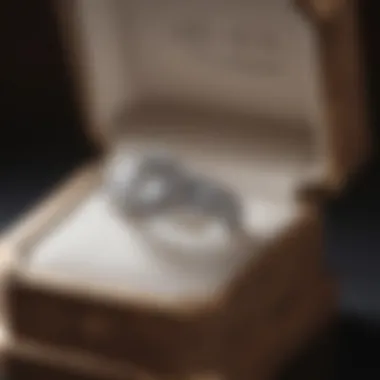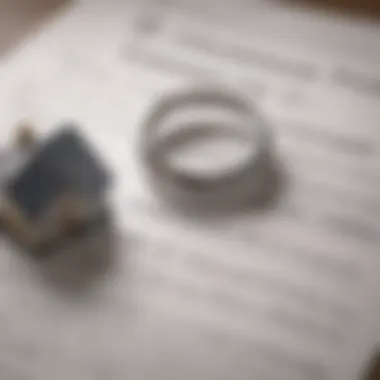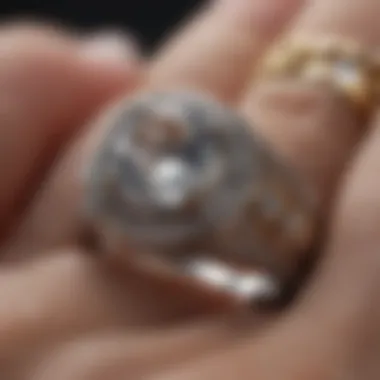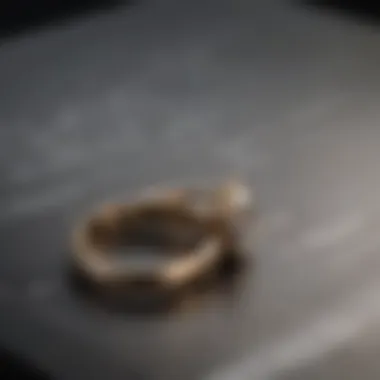Engagement Ring Coverage in Home Insurance Policies


Intro
When it comes to ensuring our valuable possessions, many individuals often overlook the fine print of their home insurance policies. Engagement rings, often seen as a symbol of love and commitment, can be particularly tricky regarding insurance coverage. Understanding how these precious pieces fit into your insurance plan is crucial for safeguarding your investment. This guide dives into the nitty-gritty of home insurance, exploring how engagement rings might be covered, the factors influencing this coverage, and what steps can be taken to ensure your sentimental and monetary investment remains protected.
Whether you're newly engaged or simply evaluating your coverage options, knowing the ins and outs of insurance policies regarding engagement rings is paramount. In this article, we will break down key concepts, explore expert advice, and equip you with the tools to make informed decisions about your jewelry insurance needs.
Investment Terminology
Understanding the jargon used in insurance can significantly affect your ability to secure proper coverage for your engagement ring. Let’s break it down:
Key Definitions
- Personal Property: This refers to any movable items owned by an individual, such as jewelry, electronics, or furniture. Engagement rings fall under this umbrella.
- Replacement Cost: This refers to the amount needed to replace an item with a similar one of like kind and quality. Knowing this can help ensure you have adequate coverage.
- Actual Cash Value: Unlike replacement cost, this takes depreciation into account. If your engagement ring were stolen or damaged, you'd receive the current value rather than what you paid.
Commonly Used Terms
- Coverage Limit: The maximum amount your insurance policy will pay for a covered loss. Make sure to review this limit to avoid being underinsured, especially for a high-value item like an engagement ring.
- Exclusion: Situations or items not covered by your policy. Knowing these exclusions is crucial, as they may include certain types of damage or losses.
- Endorsement: This is also known as a rider, an amendment to your policy that provides additional coverage for items that may not be included in the standard agreement.
"Understanding your policy's terminology is just as important as knowing its coverage, because the devil is always in the details when it comes to insurance."
Expert Advice
Navigating the world of insurance can be daunting, but expert guidance can help you make smarter choices regarding your engagement ring.
Investment Strategies
- Get an Appraisal: Before insuring your engagement ring, obtain a professional appraisal to properly value it. This will help in setting an adequate coverage limit.
- Consider Scheduling: This means adding a rider to your home policy specifically for the ring. It can provide extra peace of mind for high-value pieces.
- Regularly Review Coverage: As your life circumstances change, so should your insurance. Ensuring that your coverage evolves with the current market value is key.
Risk Management Tips
- Document Everything: Keep receipts, appraisals, and photographs of your engagement ring. This will help if you ever need to file a claim.
- Store Wisely: Invest in a good safe or consider off-site storage to minimize the risk of theft or loss.
- Understand Your Policy: Know what is included in your coverage and what steps to take in case of theft or damage. Familiarity with the claims process can save you a headache later.
Finale
The significance of an engagement ring goes beyond its monetary value; it often carries personal stories and memories. That's why understanding how to effectively insure it under your home policy cannot be overstated. With thorough knowledge of insurance terms, expert advice, and proactive management of your assets, you can ensure your engagement ring remains protected against unforeseen events. Now, take a moment to review your home insurance and make certain your jewelry is adequately covered. After all, it's better to be safe than sorry.
Understanding Home Insurance Basics
Understanding home insurance is vital for anyone who owns property, especially when considering coverage for valuable items like engagement rings. The insurance landscape can be intricate, with various policies and provisions that have implications for personal property. Recognizing these baselines helps individuals navigate the often complex interaction between home insurance and personal assets.
Home insurance primarily acts as a safety net, protecting your home and belongings against unforeseen events. Whether it's a burst pipe or a break-in, having the right insurance can make all the difference. Moreover, knowing the terms and limitations of your policy can save you from heartache if a valuable item gets damaged or stolen, such as engagement rings that often carry substantial emotional and financial weight.
Definition of Home Insurance
Home insurance is a policy that covers loss or damage to residential properties and their contents. It generally encompasses several types of coverage, such as dwelling, personal property, liability, and loss of use coverage.
The dwelling coverage protects the physical structure itself, while personal property coverage looks after the belongings inside, including furniture, electronics, and jewelry. Liability coverage can shield the homeowner from lawsuits, while loss of use typically compensates for temporary living expenses if the home becomes uninhabitable due to damage.
In practice, home insurance is about mitigating risks, helping homeowners feel more secure about their investments and reducing worries related to everyday catastrophes.
Common Types of Home Insurance Policies
There are multiple types of home insurance policies available, and each has unique features:
- HO-1: Basic form that covers only a limited set of perils.
- HO-2: Broad form policy that covers more perils compared to HO-1, including both named and unspecified peril coverage.
- HO-3: The most popular type, covering the home itself on an open perils basis, while personal property is covered on a named peril basis.
- HO-4: Also known as renters insurance, these policies protect tenant belongings but do not cover the physical structure.
- HO-5: Offers extensive coverage for both the structure and personal property, generally recommended for high-value homes.
- HO-6: Specifically for condominium owners, providing coverage for personal property and interior improvements.
- HO-7: A specialized policy for mobile homes, addressing their specific risks.
Each policy type serves different needs, and potential policyholders should evaluate their circumstances to choose the best fit.
Coverage Limits and Deductibles
When assessing home insurance policies, understanding coverage limits and deductibles is crucial. A coverage limit represents the maximum amount an insurer is willing to pay for a covered loss. If someone claims a theft of a diamond engagement ring valued at $5,000, but the policy limit for personal property is set at $2,500, only that amount would be compensated.
On the other hand, a deductible is the amount a policyholder must pay out-of-pocket before insurance kicks in. Choosing higher deductibles can lower monthly premiums, but in the event of a claim, it means the homeowner would need to bear more of the cost upfront.
Engagement Rings as Personal Property
Engagement rings often carry significant emotional and financial value, making them a unique category of personal property underhome insurance policies. Understanding how these rings classify under the umbrella of personal items is crucial for insurance coverage discussions. Not only do they symbolize commitment and love, but they also can represent a substantial investment.


When considering engagement rings, it’s important to recognize that they don’t merely belong in a jewelry box; they reflect personal stories, milestones, and future aspirations. Thus, the intricacies of how they are treated under insurance can heavily impact how one protects them. Given their importance, you’d want those rings covered in the event of theft, loss, or damage.
Classification of Engagement Rings
Classification involves categorizing the ring as either a high-value personal item or a general household good. Most insurance policies view engagement rings as personal property that falls under the umbrella of high-value items, which often require separate coverage. This distinction is vital since standard home insurance typically only provides limited coverage for personal items, usually capped at a certain percentage of the policy’s total coverage.
- High-Value Personal Property: Engagement rings, particularly those made with diamond or precious gems, can easily fall into this category, often exceeding standard limits. These items might need a scheduled endorsement to ensure adequate coverage.
- General Personal Property: Alternatively, if the ring is of lower value, it might be included within the general limits of personal property. In this case, the coverage would typically be included in the standard home insurance policy, yet it might not provide full value in case of a claim.
Verifying the classification with your insurance provider can help clarify what’s necessary for comprehensive protection. It ensures that engagement rings can withstand unforeseen events without suffering financial loss.
Value Assessment of Jewelry
Assessing the value of engagement rings is another crucial piece of the puzzle. While you might have an emotional attachment, insurance typically hinges on the market value of the item. Several factors can influence this valuation:
- Gem Quality: The quality of the diamond or gemstone, assessed by cut, color, clarity, and carat size, greatly affects valuation.
- Brand and Craftsmanship: Rings from renowned designers or crafted by skilled artisans may command higher market prices.
- Current Market Trends: Like any other commodity, jewelry values can fluctuate based on changing market demands and trends.
For insurance purposes, it’s wise to have your engagement ring appraised by a certified professional at least every few years. This helps ensure your coverage stays relevant and reflects any changes in its market value, keeping you one step ahead.
The key takeaway is simple: an accurate appraisal fortifies not only the sentimental value but also the financial protection you seek through your home insurance policy.
In summary, engaging with the specifics surrounding the classification and valuation of engagement rings is critical in advancing your understanding of their placement as personal property. This ensures a comprehensive approach to their insurance coverage, safeguarding your precious investment against unexpected circumstances.
Exploring Coverage for Engagement Rings
Engagement rings hold sentimental value beyond their monetary worth. They represent commitment and love, making their protection paramount. This section provides an in-depth analysis of engagement ring coverage within home insurance policies and the specific considerations involved. Understanding how these rings fit into insurance frameworks can guide individuals on how to safeguard their valuable assets effectively.
Are Engagement Rings Covered by Standard Policies?
When it comes to standard home insurance policies, the coverage of engagement rings can be as murky as a foggy dawn. Many homeowners operate under the misunderstanding that all personal belongings, particularly valuable ones like engagement rings, are fully covered. While a standard home insurance policy does indeed protect personal property from certain risks, it often comes with limitations, especially for high-value items.
In most cases, these policies cover theft and damage to personal property. However, engagement rings may not fall under this blanket of security depending on factors such as their value and the specific terms of the policy. For instance, a typical policy might impose limits on the amount it pays out for jewelry; often capping it at a factor significantly lower than the actual appraised value.
It's also essential to note that some policies require a ring to be documented at a specific value to qualify for coverage. This could mean obtaining an appraisal before the ring is protected under a home policy. In layman's terms, if your ring is worth its weight in gold, make sure your policy reflects that value.
Specific Exclusions and Limitations
Every rose has its thorn, and similarly, every insurance policy has its exclusions. When considering engagement ring coverage, it's crucial to be aware of the limitations. While most home insurance policies cover a variety of events, certain scenarios are often excluded from coverage for engagement rings:
- Mystery Losses: If the ring simply goes missing without any clear evidence of theft, you might be out of luck. Standard policies are unlikely to protect against this sort of loss.
- Mysterious Circumstances: If damage occurs under dubious circumstances, like if it is lost during your wild weekend at a music festival, claims may be challenged.
- Natural Disasters: Homeowners insurance typically covers certain disasters, but items can quickly jettison past basic coverage if a catastrophe strikes. A ring swept away by floodwaters might find itself unprotected under most standard policies.
- Policy Limits: Often, homeowners' insurance has dollar caps on coverage for jewelry. If your engagement ring surpasses this amount without being specifically insured, it may sit in a perilous position.
It's paramount to review your homeowner's insurance policy carefully. Not all coverage fits all needs; what's good for your neighbor might not suit you, especially when it comes to valuable possessions.
To keep your precious engagement ring safe, it may be necessary to look beyond standard coverage. Options like scheduled personal property endorsements could provide extra peace of mind. Alternatively, standalone jewelry insurance presents a tailored route with specific coverage aimed at protecting valuable items.
Understanding these exclusions and limitations can save you from a world of trouble when it comes time to file a claim. The fine print in these policies can often feel like a maze, so the best approach is to clarify doubts directly with your insurer. In the end, knowing where you stand can make all the difference between feeling safeguarded and falling short in times of need.
Additional Protection Options
Navigating the ins and outs of home insurance can feel like walking through a maze. As we’ve seen, standard home insurance often has limitations when it comes to precious items like engagement rings. That’s where exploring additional protection options comes into play. It is not just about peace of mind; it's about ensuring that your love token is genuinely safeguarded against unforeseen events.
Consider the following elements when looking into extra protection for your engagement ring:
- Increased Coverage: Regular policies may not cover the full value of your engagement ring. Additional protection options allow you to adjust coverage limits, safeguarding the true worth of your treasured piece.
- Specific Coverage for Jewelry: Standard policies often include blanket coverage for personal property, which may not specifically address jewelry. Supplementary options offer tailored protection that can cater to specific valuable items.
- Protection Against Specific Risks: Many people think theft is the only risk. However, damage due to fire, water, or loss can also jeopardize your ring. Additional protection helps cover these less obvious threats.
In short, additional insurance options not only shield your investment but empower you to make choices that align with your financial security and emotional well-being.
Scheduled Personal Property Endorsements
When it comes to protecting your engagement ring, scheduling the piece under a personal property endorsement can be a wise move. This endorsement is essentially a rider that adds specific coverage to your policy, targeting high-value items. This option offers a few significant benefits worth considering:
- Accurate Valuation: Unlike standard home insurance limits, a scheduled endorsement allows you to appraise your engagement ring accurately based on its current market value. This ensures you would receive a fair payout in case of a claim.
- Broader Coverage: Scheduled endorsements often include scenarios that a standard home policy may exclude. For example, loss or theft from anywhere, including traveling internationally, could be covered, whereas general policies may limit such circumstances.
- No Deductible: Some endorsements may offer coverage without a deductible, which means you might receive full compensation in the event of a loss. This feature can significantly ease your financial burden and stress.
To sum it up, these scheduled endorsements are tailored perfectly for valuable jewelry and can enhance your existing coverage tremendously.
Standalone Jewelry Insurance
For those seeking maximum security for their beloved engagement ring, standalone jewelry insurance might be the most prudent route. This specialized coverage often goes beyond what a standard home insurance policy offers. Here is why it could be the best fit for you:
- Tailored Coverage Plans: With standalone jewelry insurance, you often have the flexibility to design a policy that fits your specific needs and requirements. That means no more worrying about whether particular risks are covered.
- Fewer Exclusions: Many standalone policies come with fewer exclusions compared to typical home insurance, covering not just loss or theft but also accidental damage that could occur during everyday wear.
- Expert Claims Handling: Insurers specializing in jewelry often understand the nuances of precious items. This expertise can lead to a smoother and more efficient claims process when circumstances go south.


Whether you choose scheduled endorsements or standalone policies, the ultimate goal is clear: to protect your meaningful investment in a way that brings you peace of mind.
Claim Process for Damaged or Stolen Engagement Rings
When it comes to protecting your engagement ring, understanding the claim process under your home insurance policy is absolutely crucial. This process outlines the steps you must take to report a damaged or stolen piece of jewelry to your insurer, ensuring that you have the potential to recover your loss. This section delves into the specific elements that can streamline your experience, as well as some potential pitfalls to avoid. Knowing the ins and outs of this process equips you with the confidence you need to tackle unforeseen events that can jeopardize your cherished possession.
Documentation Required for Claims
Proper documentation is the bedrock of a successful claim when it comes to insurance. Without the right paperwork, you might find yourself swimming against the current, making it harder to receive reimbursement or repairs. Key documents typically include:
- Proof of Purchase: This could be a receipt or an invoice detailing the purchase price and the date of the transaction.
- Appraisal Reports: An up-to-date valuation from a certified appraiser can greatly enhance your claim, providing evidence of its worth.
- Photographs of the Jewelry: Images showing the details of the ring can serve as visual proof of its existence and condition prior to the incident.
- Police Reports: In cases of theft, documenting your report to local law enforcement is essential. It legitimizes the claim regarding the loss.
These documents not only support your claim but also expedite the process, making the insurance company's job easier in assessing your case.
Understanding the Claims Timeline
The timeline of processing a claim can vary quite a bit based on internal procedures and the nature of the incident. Generally, once you’ve submitted your claim, you can expect several key steps:
- Initial Review: Insurers usually start by acknowledging receipt of your claim within a few days. This is the onboarding stage, where they assess the information submitted.
- Investigation Period: Depending on the complexity, this can take from a week to several weeks. The insurer will check the documents, possibly reach out for more information, or may even send an adjuster to assess the situation.
- Decision Notification: After the investigation, you’ll receive a decision regarding your claim. If approved, they will detail the reimbursement or repair process.
The total process can take anywhere from a few weeks to a couple of months, depending on various factors including the policy type and the insurer's workload.
Keeping this timeline in mind helps set reasonable expectations. By being prepared and organized from the outset, you can mitigate some of the frustrations that often accompany insurance claims.
Factors Influencing Coverage Decisions
Understanding the elements that steer coverage decisions is central to grasping how engagement rings fit into home insurance. Coverage decisions aren’t made in a vacuum; they involve examining an array of factors that reflect not only the ring’s intrinsic value but also external circumstances. Evaluating these aspects can greatly aid individuals in tailoring their insurance choices to align with their unique situations. This comprehension serves not merely to protect a cherished piece of jewelry but also to secure emotional satisfaction and peace of mind.
Geographical Location Impact
Location plays a pivotal role in determining insurance coverage. For example, it might come as no surprise that those residing in urban areas with high crime rates could encounter limitations on their insurance policies. Conversely, living in a quiet suburb might favor broader coverage options. The absence or presence of various risk factors, such as localized theft incidents and natural disasters, can actively shape policy terms.
Some critical geographical factors include:
- Crime Rates: High-crime areas may lead to increased premiums or exclusions for certain items like jewelry.
- Weather Risks: Regions prone to floods, hurricanes, or other natural disasters might influence the extent of coverage offered.
- Local Laws and Regulations: Unlike neighboring states, certain areas may mandate unique insurance conditions affecting protection limits.
Rethinking your policy in light of geographical nuances can be a sensible tactic. It's essential to have discussions with insurance agents about your immediate surroundings—knowledge is power and can directly translate to more tailored protection.
Value of the Ring and Policy Limits
The monetary value of an engagement ring can significantly determine how it's treated under home insurance policies. Not all rings are created equal, and their respective market values can greatly influence coverage options. It is crucial to accurately assess the ring's value through detailed appraisals that consider factors like material quality, craftsmanship, and market demand.
Key considerations include:
- Appraisal: A proper appraisal can help ensure that the ring is valued correctly, thus influencing coverage limits.
- Policy Limits: Many home insurance policies come with caps on personal property coverage. Understanding these limits is crucial; if the ring surpasses the policy's maximum, you might end up bearing the financial brunt.
- Specialty Items: Some items of higher value might require additional endorsements or even standalone policies to ensure complete protection.
When navigating these waters, uncertainty can be tricky. Having a firm grasp of your ring’s worth in conjunction with your policy limits affords individuals clarity and could prevent facing potential financial difficulties in the case of theft or damage.
Having a strong insurance strategy is like carrying an umbrella—it may seem excessive until a sudden downpour reminds you of its value.
The Importance of Proper Appraisal
When it comes to securing the right insurance coverage for an engagement ring, ensuring that the item is appraised correctly plays a critical role. An accurate appraisal not only affects the insurability of the ring but also influences how much you can reclaim in the event of theft or damage. Simply put, a proper appraisal can mean the difference between a frustrating claim process and peace of mind regarding your cherished asset.
Finding a Qualified Appraiser
Choosing the right appraiser for your engagement ring is no small feat. It’s important to look for someone with credentials, tending towards organizations like the American Society of Appraisers or the National Association of Jewelry Appraisers. These associations often require appraisers to complete rigorous training and adhere to a code of ethics.
Here are some pointers when seeking an appraiser:
- Check Qualifications: Seek out appraisers who have certifications and extensive experience in evaluating jewelry—specifically engagement rings.
- Research Reviews: Platforms like Reddit or local directories can provide reviews about appraisers. A knowledgeable appraiser with a good reputation can make a significant difference.
- Ask About Their Process: Find out how they determine the value of the ring. A thorough appraisal should include an in-person examination, measurements, and descriptions of the gemstone and metal.
Frequency of Reappraisals
Engagement rings are often not static in value; their worth can fluctuate over time due to various economic factors, market trends, or shifts in demand for specific types of jewelry. Therefore, it is vital to understand how often to reappraise your ring. It is commonly recommended to undergo reappraisal every two to five years. This timeframe can ensure that the coverage you carry reflects the current market conditions.
Consider the following:


- Life Changes: If you experience significant life changes—such as moving to a new area or if there’s been a notable increase in the value of precious metals—it might be wise to consider an immediate re-evaluation.
- Insurance Recommendations: Your insurer may have specific guidelines regarding how frequently they recommend reappraisals, so it’s best to stay in touch with them.
Keeping an updated appraisal is crucial for maintaining proper coverage. Should you ever need to file a claim, having current documentation ensures you won’t be shortchanged due to outdated valuation. As some say, "A stitch in time saves nine," and the same goes for appraisals—being proactive today can prevent headaches tomorrow.
Understanding Policy Terms and Conditions
Understanding the policy terms and conditions is not just a tedious task; rather, it is a crucial step for anyone keen on safeguarding their engagement ring under home insurance. The intricacies of policy documents can seem overwhelming at first glance, but familiarizing yourself with the terminology and stipulations can pay substantial dividends in the event of a mishap. Knowing what is covered and what is not can be the difference between receiving a payout or bearing the loss alone.
This section sheds light on various elements you must pay attention to, as well as the benefits that come from attentive scrutiny of your insurance policy. Each insurer has its own set of rules; thus, understanding these distinctions helps you in both the short and long term.
Reviewing the Fine Print
Reviewing the fine print is akin to checking your compass before heading into the wilderness. It may seem trivial, but it guides your journey through the complexities of insurance. Important details are often buried deep within the policy, and assuming coverage is in place without reading these clauses could lead to disappointment. For example, specific conditions may restrict coverage based on the ring's value or its use.
Here are some key elements to scrutinize:
- Coverage Limits: Identify whether there’s a cap on the total amount your policy will pay out in case of theft or damage to your ring.
- Exclusions: Be aware of specific scenarios in which claims might be denied. This could include instances of loss caused by neglect or certain types of damage.
- Appraisal Requirements: Some insurers may ask for a detailed appraisal report, while others might require proof of purchase. Knowing these requirements in advance can save headaches later.
By paying attention to these details, you position yourself for prompt and fair treatment when it matters most.
Questions to Ask Your Insurer
When the conversation turns toward insuring such cherished items as engagement rings, asking the right questions can unveil the true quality of your coverage. You wouldn’t just hop on a plane without knowing its destination, so why should you settle for an insurance policy without understanding its terms? Here’s a list of essential inquiries:
- What exactly is covered?
Are there limitations on coverage related to the ring's value or the circumstances of its loss? - What’s the deductible?
Understanding how much you will pay out of pocket before your insurance kicks in will help in assessing the policy's real value. - Are there options for extending coverage?
Some insurers might offer extended policies that can be tailored to better suit your needs. - How often should my ring be appraised?
Clarifying how often you need to provide a new appraisal is vital to keep your policy up to date.
Asking these questions fosters a clearer understanding of your policy and allows greater peace of mind regarding the protection of your valuable jewelry.
"In the realm of insurance, knowledge is as valuable as the items being insured."
Armed with this knowledge, you'll be in a much stronger position to make informed choices that protect your assets.
Common Myths About Jewelry Insurance
When it comes to jewelry insurance, particularly for something as significant as engagement rings, several misconceptions cloud the conversation. Understanding these myths is crucial because they can greatly influence how individuals approach their coverage options. A lot rides on the perceptions formed by folklore or half-truths, often leading to shortsighted decisions that could put financial security at risk.
Myth vs. Reality in Coverage
One prevalent myth is that all personal property is automatically covered under a home insurance policy without any further ado. This notion can mislead many into thinking that their engagement rings, often one of the most valuable personal items they own, have blanket protection. Reality, however, is different.
While home insurance may cover some loss or damage, it usually does not cover high-value items like diamond rings to their full extent. Most policies have limits on how much can be claimed for specific categories of personal property, which could well mean that a wedding ring, valued significantly, might only be covered for a fraction of its worth.
Another common misunderstanding is that getting coverage for valuable jewelry is overly complicated and expensive. In fact, many insurers offer specific endorsements or add-ons tailored specifically for jewelry, allowing for more comprehensive protection tailored to the value of the item. Instead of seeing jewelry insurance as a cumbersome hassle, think of it as essential peace of mind.
Dispelling Misunderstandings
Misconceptions abound, such as the belief that an appraisal isn't necessary if you have receipts confirming the purchase price of the ring. While receipts are useful, they rarely reflect the current market value of the piece. Appraisal values could fluctuate significantly over time, reflecting current market trends or economic changes. Therefore, not obtaining a thorough appraisal can potentially expose you to losing out financially during a claim.
Additionally, many individuals presume that they cannot claim on their jewelry policies until the ring is lost or damaged beyond repair. However, most policies also cover incidents of theft where the item is still missing, allowing for a claim to be made more promptly rather than waiting for situations that rarely materialize.
"Being informed is half the battle. Understanding what your policy covers can save you time and money in the long run."
By debunking these myths and misconceptions, you can better navigate the intricacies of insurance policies, paving the way for informed decisions regarding your beloved jewelry.
Final Considerations and Recommendations
When embarking on the journey of insuring your engagement ring, understanding your options and evaluating your needs is half the battle. This section ties it all together, emphasizing key aspects you should ponder before making decisions regarding insurance coverage for your precious possession.
Evaluating Your Personal Needs
Engagement rings often carry not just monetary value, but emotional weight too. Therefore, evaluating your personal needs becomes paramount. Consider the following elements:
- Type of Lifestyle: Do you frequently travel or stay at home? Your lifestyle might dictate the kind of coverage you need. A diamond ring with sentimental value might require more stringent protection if you’re often on the move.
- Value and Rarity of the Ring: Higher value rings, such as those from established jewelers like Tiffany & Co. or Cartier, may necessitate a specialized policy compared to everyday jewelry. If the ring is unique or custom made, its individuality can factor into assessment.
- Current Home Security: If you live in a neighborhood with a high rate of theft, you’ll want a policy that protects against that. Conversely, if your home has a state-of-the-art security system, maybe you need less coverage.
Assessing these factors will help you determine what type of coverage suits you. The goal is to protect your ring against unforeseen damages or theft, yet also not to pay excessively for coverage that you don’t necessarily need.
Making an Informed Decision
Armed with knowledge, it's time to make an informed decision. Here are several steps to help clarify your path:
- Seek Expert Opinions: Consulting insurance agents familiar with jewelry coverage could provide insight that is invaluable. They can help navigate the labyrinth of available policy options.
- Compare Policy Options: Don't rush into signing on any dotted line. Comparing different insurers, looking into customer reviews, and understanding their claim settlement processes is essential. Check platforms like Reddit for real stories from other ring holders who have filed claims.
- Understand Your Policy: Once you’ve chosen a policy, grasp the terms and limitations. Be sure to take note of exclusions, and clarify all details with your agent in case of any doubts.
- Document Inventory: Keeping an updated inventory, including photographs and appraisals, will facilitate the claims process if needed. Having solid documentation is like having an ace up your sleeve.
“Knowledge is power; foundational to making informed decisions.”
In essence, the combination of evaluating personal needs and making educated choices can make all the difference in not just securing coverage, but also ensuring peace of mind when it comes to protecting your treasured engagement ring.















